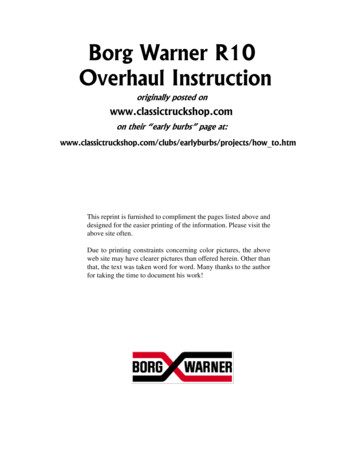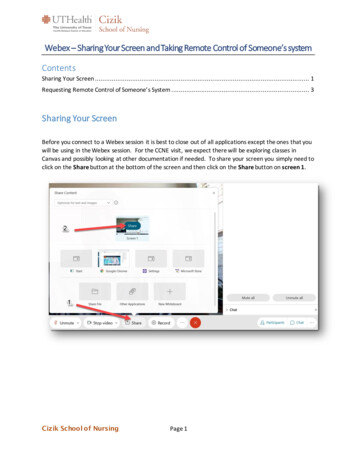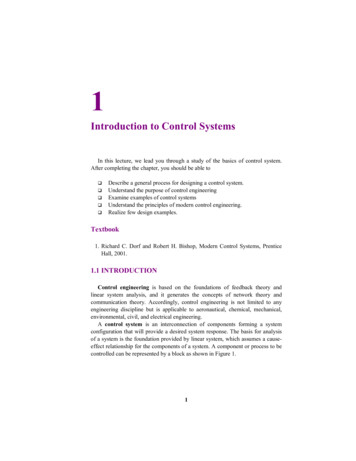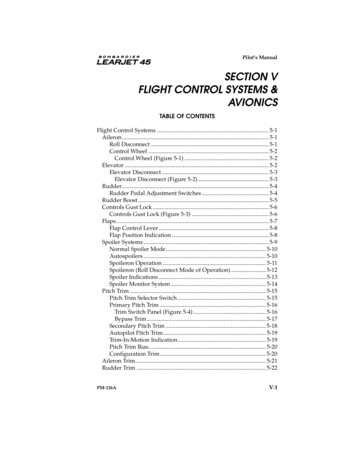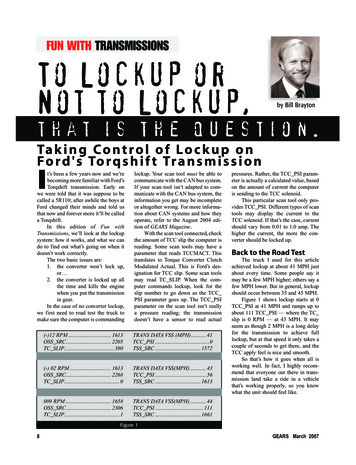
Transcription
FUN WITH TRANSMISSIONSby Bill BraytonTa k i n g Co n t r o l o f L o c k u p o nFo r d ' s To r q s h i f t Tr a n s m i s s i o nIt’s been a few years now and we’rebecoming more familiar with Ford’sTorqshift transmission. Early onwe were told that it was suppose to becalled a 5R110; after awhile the boys atFord changed their minds and told usthat now and forever more it’ll be calleda Torqshift.In this edition of Fun withTransmissions, we’ll look at the lockupsystem: how it works, and what we cando to find out what’s going on when itdoesn’t work correctly.The two basic issues are:1. the converter won’t lock up,or 2. the converter is locked up allthe time and kills the enginewhen you put the transmissionin gear.In the case of no converter lockup,we first need to road test the truck tomake sure the computer is commandinglockup. Your scan tool must be able tocommunicate with the CAN bus system.If your scan tool isn’t adapted to communicate with the CAN bus system, theinformation you get may be incompleteor altogether wrong. For more information about CAN systems and how theyoperate, refer to the August 2004 edition of GEARS Magazine.With the scan tool connected, checkthe amount of TCC slip the computer isreading. Some scan tools may have aparameter that reads TCCMACT. Thistranslates to Torque Converter ClutchModulated Actual. This is Ford’s designation for TCC slip. Some scan toolsmay read TC SLIP. When the computer commands lockup, look for theslip number to go down as the TCCPSI parameter goes up. The TCC PSIparameter on the scan tool isn’t reallya pressure reading; the transmissiondoesn’t have a sensor to read actual(-)12 RPM . 1613OSS SRC. 2205TC SLIP. 390TRANS DATA VSS (MPH) . 41TCC PSI . .0TSS SRC . 1572(-) 02 RPM . 1613OSS SRC. 2268TC SLIP. 0TRANS DATA VSS(MPH) . 43TCC PSI . 56TSS SRC . 1613009 RPM . 1658OSS SRC. 2306TC SLIP. 1TRANS DATA VSS(MPH) . 44TCC PSI . 111TSS SRC . 1661pressures. Rather, the TCC PSI parameter is actually a calculated value, basedon the amount of current the computeris sending to the TCC solenoid.This particular scan tool only provides TCC PSI. Different types of scantools may display the current to theTCC solenoid. If that’s the case, currentshould vary from 0.01 to 1.0 amp. Thehigher the current, the more the converter should be locked up.Back to the Road TestThe truck I used for this articleachieved lockup at about 41 MPH justabout every time. Some people say itmay be a few MPH higher; others say afew MPH lower. But in general, lockupshould occur between 35 and 45 MPH.Figure 1 shows lockup starts at 0TCC PSI at 41 MPH and ramps up toabout 111 TCC PSI — where the TCslip is 0 RPM — at 43 MPH. It mayseem as though 2 MPH is a long delayfor the transmission to achieve fulllockup, but at that speed it only takes acouple of seconds to get there, and theTCC apply feel is nice and smooth.So that’s how it goes when all isworking well. In fact, I highly recommend that everyone out there in transmission land take a ride in a vehiclethat’s working properly, so you knowwhat the unit should feel like.Figure 188bill-lockup.indd 8GEARS March 20072/7/07 3:13:52 PM
Figure 2What to Do If All GoesWrongDuring the road test, this 2004F450 6.0L diesel works fine in all theforward ranges, but the driver can’tfeel lockup. As with all electronicallycontrolled transmissions, you need todetermine whether the problem is insideor outside the transmission.GEARS March 20078bill-lockup.indd 9On this particular unit the technician replaced all the solenoids, including the TCC solenoid, so chances arethe solenoid isn’t the problem.A road test with scan tool showsthe TCC PSI goes up to about 111PSI at about 43 MPH, but the TC slipdoesn’t go down much, if at all.Right about now many technicianswould be guessing the torque converteris at fault, and would start removing theunit on a guess.How's It Work?Before we go any further, let’slook at exactly how the lockup systemworks.The lockup valve begins in the off,92/8/07 4:49:05 PM
To Lockup or Not to Lockup, that is the question.Figure 3Figure 5Figure 4108bill-lockup.indd 10Figure 6or unlocked position (figure 2). The lockup solenoid receivesline pressure from the manual valve whenever the engine isrunning. Because the lockup solenoid is normally closed, theoil is blocked from reaching the lockup valve.When the computer energizes the lockup solenoid, fluidflows to the lockup valve (figure 3). This causes the valveto stroke and dump converter release oil, allowing lockup totake place. It’s really just that simple.Here’s a quick method for testing the pump and converterat the same time, using a tool you can build in 3 easy steps,from an old TCC solenoid:Step 1: Bend the 4 tabs back with a screwdriver (figure 4).Step 2: Remove the solenoid parts (figure 5). It isn’tnecessary to remove the allen screw and spring from the tipGEARS March 20072/8/07 4:49:15 PM
. Equaplsoceaendifm.lueay. VtnrraWa.ytaliuQGM Transmissions: With the strength of GM squarely behind you.New toll-free Powertrain Contact Center for all your questionsNew 3-year/100,000-mile nationwide limited warranty* (parts & labor)GM remanufactured transmissions feature OE quality that incorporatesall the latest engineering updates. Built specifically for each GM vehiclewith Plug-n-Play design for low hoist time. Typically available the sameor next day. Contact your GM dealer or call: 866-453-4123. Goodwrench.com*36 months or 100,000 miles, whichever comes first. 2006 GM Corp. All rights reserved.gm plcd.indd 236/1/06 2:54:56 PM
To Lockup or Not to Lockup, that is the question.Figure 7Figure 9Figure 8If the enginestalls withthe test tool inplace, theconverter clutchand lockup valveare workingproperly.of the solenoid.Step 3: Secure the solenoid plungerto the solenoid snout with a small hoseclamp (figure 6). Be sure to align thehose clamp screw with the flat on thesolenoid snout (figure 7). If it isn’taligned properly, it won’t fit into thesolenoid body.128bill-lockup.indd 12A small piece of debris can fallinto the solenoid feed orificeand block fluid from reaching thesolenoid. In this case, the converterwill never lock up, even with the tool,because there’s no fluid to the solenoid. Be sure to checkand clean the orifice to prevent this from happening.Now you’re ready to put your newtool to work on the transmission: Drop the pan down and replacethe TCC solenoid with the tool(figure 8). Replace the pan and thefluid. and you’re ready togo.I’ve done this procedure and ittakes only 20 minutes, if that.CAUTION: This will engage theTCC all the time, and in all ranges. Ifthe torque converter and pump are operating properly, the transmission willkill the engine as soon as you put it ingear. Engaging the transmission withthe TCC applied will be very hard onthe TCC lining, so keep your testing toa minimum.If the engine stalls with the testtool in place, the converter clutch andlockup valve are working properly. Wealready know the computer signals arecorrect. At this point, there’s one likelyproblem: The brand new TCC solenoidisn’t functioning correctly. But then,who’s ever heard of a brand new sole-noid failing?What if the engine doesn’t stallwith the test tool in place? That leavesvery few possibilities: Either the lockupvalve is completely stuck or is installedincorrectly, or the torque converter hasa serious internal problem.Another possibility I’ve heardabout — but only once! — is a smallpiece of debris can fall into the solenoidfeed orifice (figure 9) and block fluidfrom reaching the solenoid. In this case,the converter will never lock up, evenwith the tool, because there’s no fluidto the solenoid. Be sure to check andclean the orifice to prevent this fromhappening.The Engine Stalls in AnyGearThis is the exact opposite of thefirst problem and, once again, we canuse an old TCC solenoid to make atest tool. But this time we don’t haveto disassemble the TCC solenoid completely:GEARS March 20072/7/07 3:14:43 PM
Figure 10Figure 11Figure 12Figure 13Step 1: Remove the end cap (figure10).Step 2: Use a 4mm allen wrench toremove the screw and spring from thetip of the solenoid (figures 11 & 12).Step 3: Install checkballs into thesolenoid snout to block the solenoid;then reinstall the allen screw (figure13).The idea is to block the valve inthe solenoid. This will physically shutGEARS March 20078bill-lockup.indd 13off fluid flow to the TCC valve in thepump.Just as before, drop the pan andreplace the TCC solenoid with themodified solenoid. If the engine stillstalls when put into gear, the problemis internal. The converter may be seizedup internally or the valve in the pumpwould have to be completely stuck inthe lockup position. Either way, thetransmission has to come out of thetruck.Torque converter clutch problemsdo occur from time to time and it helpsto have the tools to make a positivediagnosis so you know for sure you’remaking good use of your precious time.Once you know what’s going on and aremoving in the right direction, it becomeseasy to have Fun with Transmissions!132/7/07 3:15:30 PM
The two basic issues are: 1. the converter won't lock up, or 2. the converter is locked up all the time and kills the engine when you put the transmission in gear. In the case of no converter lockup, we first need to road test the truck to make sure the computer is commanding lockup.






